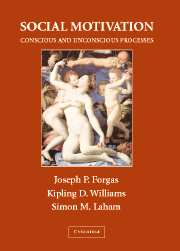Book contents
- Frontmatter
- Contents
- About the Editors
- List of Contributors
- Preface
- The Sydney Symposium of Social Psychology series
- 1 Social Motivation: Introduction and Overview
- PART I CONSCIOUS AND UNCONSCIOUS SOCIAL MOTIVATION: GENERAL ISSUES
- 2 Multiple Goals, Optimal Motivation, and the Development of Interest
- 3 The Machine in the Ghost: A Dual Process Model of Defense Against Conscious and Unconscious Death-Related Thought
- 4 Habits and the Structure of Motivation in Everyday Life
- 5 Motivation in Social Settings: Studies of Effort-Related Cardiovascular Arousal
- 6 Reflection and Impulse as Determinants of Conscious and Unconscious Motivation
- 7 The Role of Motivation in the Unconscious: How Our Motives Control the Activation of Our Thoughts and Shape Our Actions
- PART II SOCIAL MOTIVATION: COGNITIVE AND AFFECTIVE IMPLICATIONS
- PART III CONSCIOUS AND UNCONSCIOUS SOCIAL MOTIVATION: SOME CONSEQUENCES AND APPLICATIONS
- Author Index
- Subject Index
- References
3 - The Machine in the Ghost: A Dual Process Model of Defense Against Conscious and Unconscious Death-Related Thought
Published online by Cambridge University Press: 04 August 2010
- Frontmatter
- Contents
- About the Editors
- List of Contributors
- Preface
- The Sydney Symposium of Social Psychology series
- 1 Social Motivation: Introduction and Overview
- PART I CONSCIOUS AND UNCONSCIOUS SOCIAL MOTIVATION: GENERAL ISSUES
- 2 Multiple Goals, Optimal Motivation, and the Development of Interest
- 3 The Machine in the Ghost: A Dual Process Model of Defense Against Conscious and Unconscious Death-Related Thought
- 4 Habits and the Structure of Motivation in Everyday Life
- 5 Motivation in Social Settings: Studies of Effort-Related Cardiovascular Arousal
- 6 Reflection and Impulse as Determinants of Conscious and Unconscious Motivation
- 7 The Role of Motivation in the Unconscious: How Our Motives Control the Activation of Our Thoughts and Shape Our Actions
- PART II SOCIAL MOTIVATION: COGNITIVE AND AFFECTIVE IMPLICATIONS
- PART III CONSCIOUS AND UNCONSCIOUS SOCIAL MOTIVATION: SOME CONSEQUENCES AND APPLICATIONS
- Author Index
- Subject Index
- References
Summary
INTRODUCTION
The proposition that people are often unaware of the forces that lead them to do the things they do is one of the oldest, most widely accepted, but at times most controversial ideas in the history of psychology. Since psychology's inception, the popularity of accounts of behavior that emphasize unconscious motivational forces has waxed and waned. Although virtually all psychologists probably agree that people are typically not aware of all the forces and processes that determine their behavior, the idea that people's thoughts, feelings, and actions are driven by powerful fears and needs of which they are unaware is considerably more contentious. Building on earlier theorizing in existential philosophy and psychoanalytic psychology, Terror Management Theory (TMT; Greenberg, Pyszczynski, & Solomon, 1986; Solomon, Greenberg, & Pyszczynski, 1991) posits that a very deeply rooted fear of death unique to our species motivates a great deal of human behavior. A substantial literature consisting of over 170 separate studies conducted in at least nine different countries has accumulated over the past 15 years, supporting a variety of hypotheses derived from TMT (for reviews, see Greenberg, Solomon, & Pyszczynski, 1997; Pyszczynski, Solomon, & Greenberg, 2003). This research demonstrates that thoughts of death affect a broad range of human behavior, but that these effects occur in the absence of consciously experienced affect and occur primarily when death-related thoughts are on the fringes of consciousness.
- Type
- Chapter
- Information
- Social MotivationConscious and Unconscious Processes, pp. 40 - 54Publisher: Cambridge University PressPrint publication year: 2004
References
- 4
- Cited by



